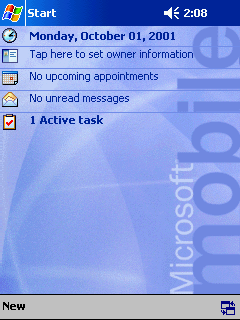Pocket PC 2002
In this article, we will explore the impact of Pocket PC 2002 on contemporary society. Since its emergence, Pocket PC 2002 has captured the attention and curiosity of people of all ages and cultural backgrounds. Over the years, Pocket PC 2002 has proven to be a topic of constant debate and has generated a variety of opinions and perspectives. Through detailed analysis, we will examine how Pocket PC 2002 has influenced different aspects of everyday life, from the way we communicate to how we entertain and educate ourselves. This article seeks to provide a comprehensive view of Pocket PC 2002 and its importance in today's society.
| Version of the Windows Mobile operating system | |
 | |
 Pocket PC 2002's interface | |
| Developer | Microsoft |
|---|---|
| Source model | Closed source |
| Released to manufacturing | October 4, 2001 |
| Platforms | ARM |
| Kernel type | Windows CE |
| Preceded by | Pocket PC 2000 |
| Succeeded by | Windows Mobile 2003 |
| Support status | |
| Unsupported as of October 14, 2008 | |
Pocket PC 2002, originally codenamed "Merlin",[1] was a member of the Windows Mobile family of mobile operating systems, released on October 4, 2001. Like Pocket PC 2000, it was based on Windows CE 3.0. Although mainly targeted for 240×320 (QVGA) Pocket PC devices, Pocket PC 2002 was also used for Pocket PC phones (Pocket PC 2002 Phone Edition), devices that combined the PDA with cellular connectivity.[2][3]
Aesthetically, Pocket PC 2002 was meant to be similar in design to the then newly released Windows XP. Newly added or updated programs include[4][5][6][7] Windows Media Player 8 with streaming capability, MSN Messenger, and Microsoft Reader 2, with digital rights management support. Upgrades to the bundled version of Office Mobile include a spell checker and word count tool in Pocket Word and improved Pocket Outlook. Connectivity was improved with file beaming on non-Microsoft devices such as Palm OS, the inclusion of Terminal Services and Virtual Private Networking support, and the ability to synchronize folders. Other upgrades include an enhanced UI with theme support and savable downloads and WAP in Pocket Internet Explorer.
On the technical side of things, Pocket PC 2002 removed MIPS and SuperH CPU support, only supporting the ARM architecture.[8] Another software platform on the same base designed for smartphones (Smartphone 2002) was also released, which were mainly keypad-style GSM devices.[9] With future releases, the Pocket PC and Smartphone lines would increasingly collide as the licensing terms were relaxed allowing OEMs to take advantage of more innovative, individual design ideas.
See also
- Pocket PC 2000 – Version of the Windows Mobile operating system
- Windows Mobile 2003 – Version of the Windows Mobile operating system
- Windows Mobile 5.0 – Version of Windows Mobile, released in 2005
- Windows Mobile 6.0 – Discontinued mobile operating system by Microsoft
- Windows Mobile 6.1 – Discontinued mobile operating system by Microsoft
- Windows Mobile 6.5 – Mobile operating system by Microsoft
References
- ^ De Herrera, Chris. "Windows CE/Windows Mobile Versions". Pocket PC FAQ. Retrieved September 6, 2007.
- ^ "Microsoft Unveils Pocket PC 2002 Phone Edition". www.itprotoday.com. Retrieved 2024-11-05.
- ^ Morris, John; Taylor, Josh (November 13, 2001). "Microsoft jumps on the all-in-one bandwagon". ZDNet.
- ^ "Announcing the New Pocket PC 2002". Microsoft. Archived from the original on January 24, 2002.
- ^ Gray, Douglas. "HP to unveil Jornada 560 series of handhelds". IT World. Archived from the original on July 14, 2007.
- ^ Gray, Douglas. "Palming new handhelds: Pocket PC 2002". CNN. Retrieved September 14, 2007.
- ^ De Herrera, Chris. "The Pocket PC 2002 Gets More Features for Work and Play". Pocket PC Magazine. Archived from the original on October 11, 2007.
- ^ "Microsoft Pocket PC to lock out non-ARM chips". ZDNet.
- ^ "Microsoft's phone software ready to talk". CNET. Retrieved 2024-11-05.